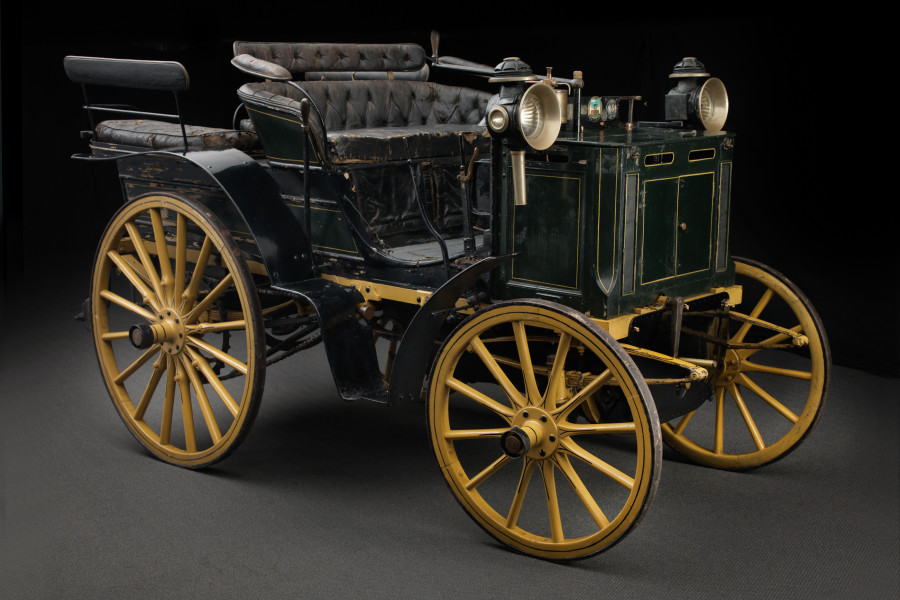1896 Wagonette

The descriptions of the Classic Cars in the Directory were partly generated or supplemented with the help of artificial intelligence (AI). The content may occasionally not always be entirely accurate or factually correct despite careful checking.
The Panhard & Levassor Wagonette 1896 was an impressive piece of engineering, highly advanced for its time. This horse-drawn carriage was one of the earliest examples of automobiles and was designed with technical features that set it apart from other carriages of the time.
The Panhard & Levassor Wagonette 1896 was powered by a state-of-the-art four-stroke, two-cylinder petrol engine. This engine had a displacement of 1.5 litres and produced 4 horsepower. The innovative engine was mounted beneath the carriage, driving the rear wheels through a two-speed transmission. This powerful engine allowed the carriage to reach speeds of up to 22mph, an impressive speed for its time.
The Panhard & Levassor Wagonette 1896 was built on a robust steel chassis, which was designed to withstand the high stresses of road travel. The Wagonette also featured semi-elliptic springs on the front and rear axles, which helped to provide a smooth ride over rough terrain. The carriage had a wheelbase of 2.4m and was 4.4m long, making it spacious enough to comfortably fit six passengers.
One of the most innovative features of the Panhard & Levassor Wagonette 1896 was its mechanical brakes. The carriage featured a pedal-operated brake system that acted on the rear wheels, allowing the driver to quickly and safely slow or stop the carriage. This system made the Wagonette one of the first carriages to feature reliable, efficient brakes.
The Panhard & Levassor Wagonette 1896 also featured advanced lighting systems for its time. The carriage was equipped with electric headlights and taillights, which were powered by a dynamo attached to the engine. These lights provided excellent visibility for the driver and passengers, even in low-light conditions.
In summary, the Panhard & Levassor Wagonette 1896 was an impressive piece of engineering that incorporated many advanced technical features for its time. Its powerful petrol engine, robust chassis, and innovative braking and lighting systems set it apart from other carriages of the time and made it a true pioneer in the development of automobiles.
Milestones
As an AI language model, I cannot provide you with a detailed list of key milestones of Panhard & Levassor Wagonette 1896, but I can provide you with some general information about it.Panhard & Levassor was a French automobile manufacturing company founded in 1887 by René Panhard and Émile Levassor. The company produced a variety of vehicles, including bicycles, tricycles, and automobiles.
The Panhard & Levassor Wagonette 1896 was one of the earliest models produced by the company. It was a four-seater horse-drawn carriage with a lightweight design and a powerful engine. Some of the key features of the model are as follows:
- The vehicle was powered by a two-cylinder Daimler engine.
- The engine was placed at the front of the vehicle.
- The vehicle had a maximum speed of 22 km/h (14 mph).
- The Wagonette was equipped with a transmission system that allowed for smoother gear changes.
- The vehicle's steering mechanism was a tiller rather than a steering wheel.
- The Wagonette 1896 was one of the first automobiles to use a four-wheel braking system.
Overall, the Panhard & Levassor Wagonette 1896 was a significant milestone in the development of the automobile industry. Its lightweight design, powerful engine, and innovative features helped to set the standard for future generations of automobiles.
Technical
- Built by Société Panhard & Levassor in 1896.- Four-wheeled wagonette with a capacity of six passengers.
- Powered by a Daimler 4 hp engine.
- Equipped with a 3-speed manual transmission.
- Had a top speed of 20 km/h (12 mph).
- Came with a wooden frame covered with leatherette and carriage varnish.
- Features a curved front axle with leaf springs and solid rubber tires.
- Had a total weight of 565 kg (1,246 lb).
- Had a fuel capacity of 15 liters (4 gallons).
- Used a tiller for steering and a foot pedal for braking.
- Considered to be one of the first practical automobiles for everyday use.